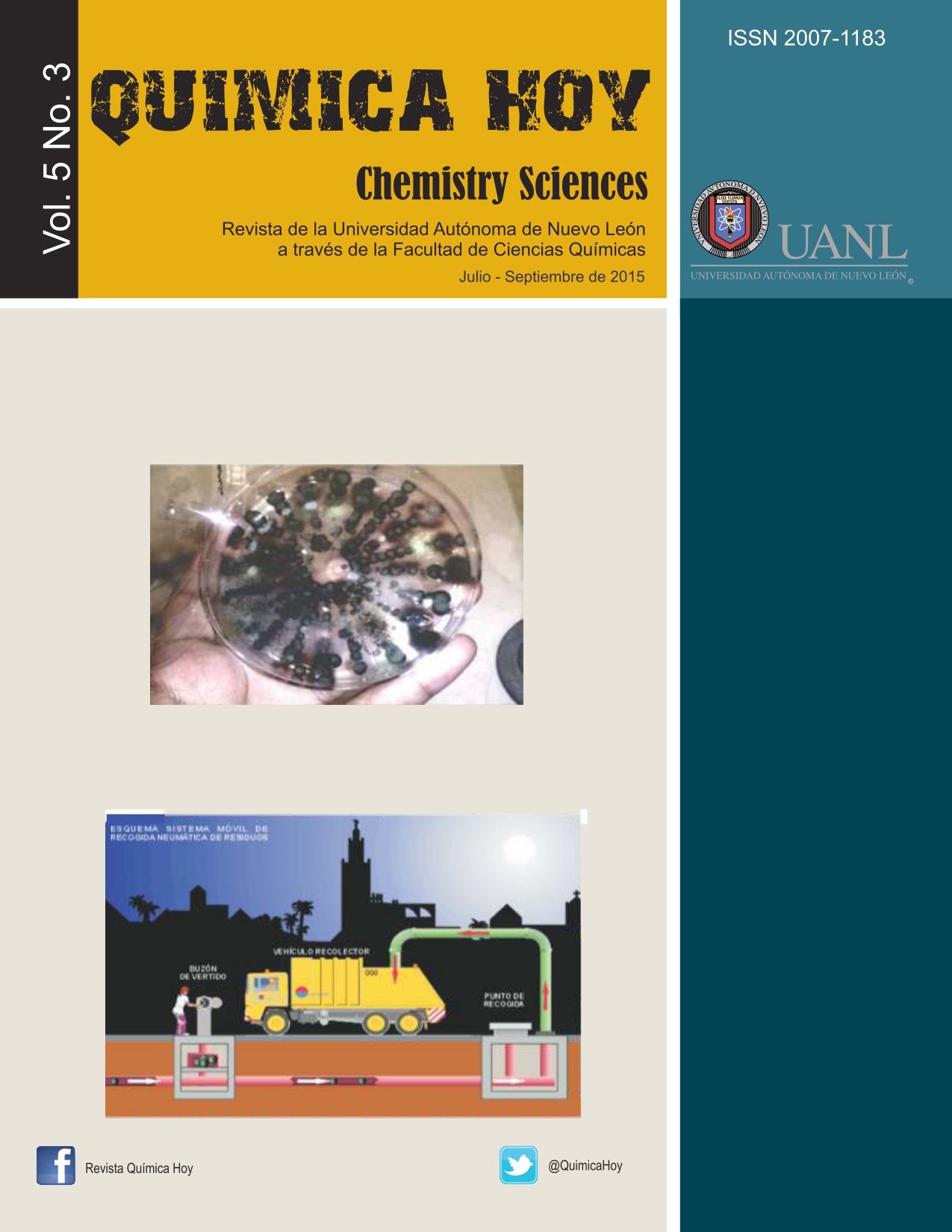Oxidación Electroquímica de di(2-etilhexil)ftalato
DOI:
https://doi.org/10.29105/qh5.3-180Keywords:
di(2-etilhexil)ftalato (DEHP), electrooxidación, Nb/BDDAbstract
El compuesto di(2-etilhexil)ftalato (DEHP) es uno de los microcontaminantes más frecuentemente detectados en aguas
residuales y en lixiviados alrededor del mundo, debido a su utilización durante décadas en la producción de plásticos. El
objetivo de esta investigación fue determinar la viabilidad de la remoción del DEHP por medio del proceso de oxidación
electroquímica, elucidando el efecto de diferentes variables como el tipo de electrolito soporte, la intensidad de corriente,
el material del ánodo y el tiempo de reacción. Se evaluaron cuatro electrolitos (NaBr, NaNO3, Na2SO4, NaCI), tres tipos de
materiales para los ánodos (Ti/Ir02, Ti/Ir02-RuO2 y Nb/BDD), diferentes intensidades de la corriente (0.2-3.0 A) y tiempos
de reacción hasta 120 min. La mayor remoción del DEHP, de 87%, se obtuvo con el electrodo Nb/BDD usando como
electro lito el NaiSO4 y aplicando una intensidad de la corriente de 0.5 A durante 120 min. El tiempo de vida media en estas
condiciones fue de 51 min. Además, los resultados obtenidos indicaron que el material del ánodo influye sobre su desempeño en el proceso de electrooxidación y que es posible lograr altas remociones del DEHP usando bajas intensidades de corriente (0.2-0.5 A). El consumo energético fue calculado entre 0.43 yl.5 kWh/m3. Se determinó el costo del tratamiento con base en el consumo energético y de electrolito soporte.
Downloads
References
-[1] Magdouli S., Daghrir R., Brar S. K., Drogui P. y Tyagi R. D. (2013). Di (2-ethylhexyl) phtalate in the aquatic and terrestrial environment: A critica! review. Journal of Environmental Management, 127, 36-49. DOI: https://doi.org/10.1016/j.jenvman.2013.04.013
-[2] Zolfaghari M,. Drogui P, Seyhi B., Brar S. K., Buelna G. y Dubé R. (2014). Occurrence, fate and effects of Di (2- ethylhexyl) phthalate in wastewater treatment plants: A review. Environmental pollution, 194, 281 - 293. DOI: https://doi.org/10.1016/j.envpol.2014.07.014
-[3] Marttinen, S. K., Kettunen, R. H., Sorrnunen, K. M. y Rintala J. A (2003). Removal ofbis (2-ethylhexyl) phthalate at a sewage treatment plant. Water research, 37(6), 1385-1393. DOI: https://doi.org/10.1016/S0043-1354(02)00486-4
-[4] Comninellis Christos, Agnieszka Kapalka, Sixto Malato, Simon A Parsons, Ioannis Poulios y Dionissios Mantzavinos. (2008). Perspective Advanced oxidation processes for water treatment: advances and trends for R&D. J Chem Technol Biotechnol, 83, 769 776. DOI: https://doi.org/10.1002/jctb.1873
-[5] García-Gómez, P. Drogui, F. Zaviska, B. Seyhi, P. Gortarés, G. Buelna, C. Neira-Sáenz, M. Estrada-Alvarado yR.G. UlloMercado. (2014). Experimental design methodology applied to electrochemical oxidation of carbamazepine using Ti/Pb02 and Ti/BDD electrodes. Journal of Electroanalytical Chemist,y. http://dx.doi.or~l 0.1O16/j.jelechem.2014.08.032 DOI: https://doi.org/10.1016/j.jelechem.2014.08.032
-[6] Panizza M. y Giacomo C. (2007). Electrocatalytic materials for the electrochemical oxidation of synthetic dyes. Applied Catalysis B: Environmental, 75, 95-101. DOI: https://doi.org/10.1016/j.apcatb.2007.04.001
-[7] Cañizares P., Lobato J., Paz R., Rodrigo M. A. y Sáez C. (2005). Electrochemical oxidation of phenolic wastes with boron-doped diamond anodes. Water Researc., 39, 2687-2703. DOI: https://doi.org/10.1016/j.watres.2005.04.042
-[8] Murugananthan S.S., Latha G., Raju B., Yoshihara S. (2010). Anodic oxidation ofketoprofen -An anti-inflammatory drug using boron doped diamond and platinum electrodes. Journal ofHazardous Materials, 180,753-758 DOI: https://doi.org/10.1016/j.jhazmat.2010.05.007
-[9] Tran N. y Drogui P. (2013). Electrochemical removal of microcystin-LR from aqueous solution in the presence ofnatural
organic pollutants. Journal ofEnvironmental Management, 114, 253-260. DOI: https://doi.org/10.1016/j.jenvman.2012.10.009
-[10] Tran N., Drogui P., Zaviska F. y Brar S. K. (2013). Sonochemical degradation of the persistent pharrnaceutical carbamazepine. Journal of Environmental Management, 131, 25-32. DOI: https://doi.org/10.1016/j.jenvman.2013.09.027
Chen C. Y., Wu P. S. y Chung Y. C. (2009). Coupled biological and photo-Fenton pretreatment system for the removal of Di-(2-ethylhexyl) phthalate (DEHP) from water. Bioresource technology, 100, 4531-4534. DOI: https://doi.org/10.1016/j.biortech.2009.04.020
-[12] Chen, C. Y. (2010). The oxidation of Di-(2-ethylhexyl) phthalate (DEHP) in aqueous solution by UV/H2O2 photolysis. Water, Air, & Soil Pollution, 209, 411-417. DOI: https://doi.org/10.1007/s11270-009-0209-3
-[13] Daghrir R., Drogui P. y Tshibangu J. (2014). Efficient treatment of domestic wastewater by electrochemical oxidation process using bored doped diamond anode. Separation and Purifica/ion Technology, 131, 79--83 DOI: https://doi.org/10.1016/j.seppur.2014.04.048
Downloads
Published
How to Cite
Issue
Section
License
Copyright (c) 2015 J.D García Espinoza , P. Drogui, M.T. Orta Ledesma , G. Buelna, P. Gortares Moroyoqui, P. Mijaylova

This work is licensed under a Creative Commons Attribution 4.0 International License.





